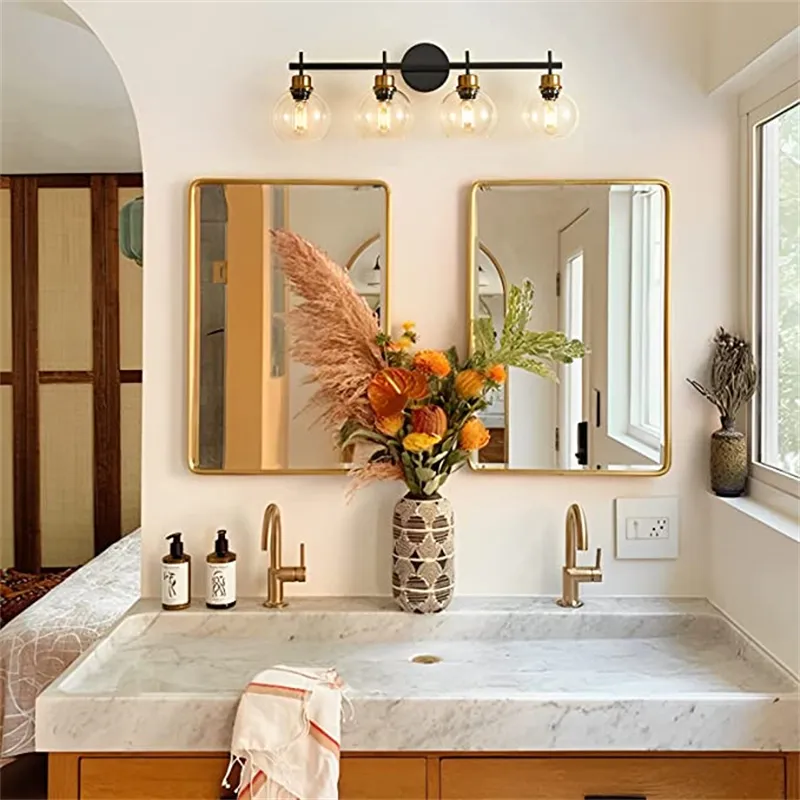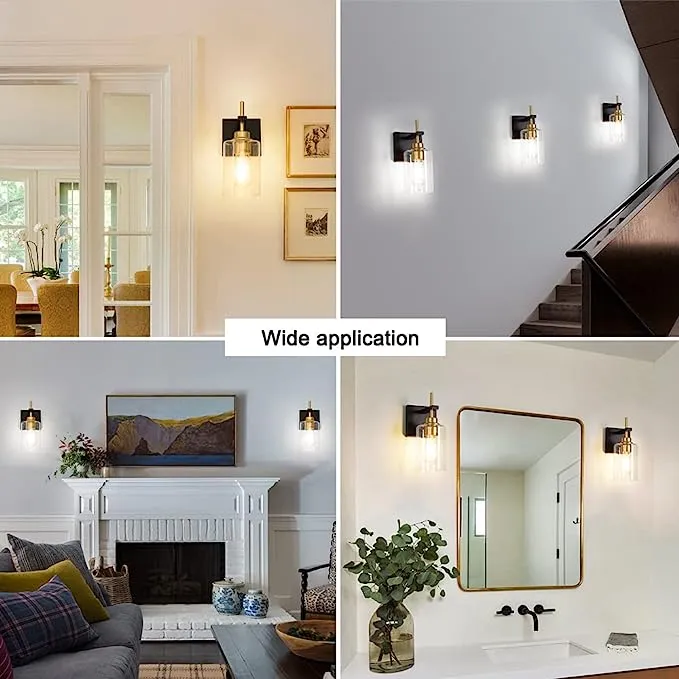What Are the Rules of Thumb for Bathroom Vanity Lighting?
In a bathroom, a vanity light is not just a functional lighting fixture, but a key element influencing the overall atmosphere and visual effect.
A well-designed vanity light provides ample and even light for makeup, shaving, and daily grooming, while also enhancing the overall aesthetics of the bathroom.
However, many people encounter questions when choosing or installing one:
• What size should the bathroom vanity light be?
• Should the light be installed above or to the sides of the mirror?
• What is the ideal distance between the light and the mirror?
To answer these questions, we must return to the core principle of design—the rule of thumb. This article will delve into the professional rules of thumb for installing bathroom vanity lights, helping you to place the light in the most suitable position the first time.

What are the rules of thumb for "bathroom vanity lighting"?
In the field of lighting design, the rule of thumb refers to universally applicable guidelines or proportional standards developed through long-term practice.
For bathroom vanity lights, there are three core dimensions:
• Fixture width and vanity proportion
• Installation height and location
• Light direction and color temperature control
A basic and widely used rule of thumb is:
✅ Choose a light fixture that is approximately 75% the width of your vanity and install it directly above the mirror, about 75 to 85 inches above the mirror.
In other words, assuming your vanity is 48 inches wide, the ideal bathroom vanity light should be around 36 inches wide.
This proportion maintains visual balance while ensuring the light covers the entire mirror surface without excessive spillage.
Why should the width of the bathroom vanity light be three-quarters the width of the vanity?
Many people struggle with the width proportion of the fixture when choosing a bathroom vanity light.
Too short will make the light appear concentrated and uneven; too wide will make the space feel cramped and uncoordinated.
1. The Principle of Balanced Light Distribution
When the width of the light fixture is approximately three-quarters the width of the vanity, the light can perfectly cover the entire mirrored area.
The light is neither concentrated in the center nor wasted on the edge walls, thus achieving the best balance between illumination and aesthetics.
2. Harmonious Visual Proportions
From an aesthetic point of view, the vanity, mirror, and light fixture should form a "golden ratio."
The light fixture is slightly smaller than the width of the vanity, which allows the visual center to focus on the mirrored area while maintaining a sense of lightness in the space above.
3. Ease of Installation and Maintenance
A suitable width also makes it easier to install the light fixture in a centered position, facilitating the concealment of wiring and brackets, while reducing the risk of glare.

What is the ideal installation height for a bathroom vanity light?
Installation height is a key parameter affecting the lighting effect of a bathroom vanity light.
If the light is installed too high, shadows will appear on the face; if it is installed too low, it may shine directly into the eyes, causing glare.
1. General Height Recommendations
• Top-Mounted: Base of the light fixture approximately 75 to 80 inches (190–203 cm) from the ground;
• Side-Mounted: Center of the light fixture approximately 65 to 70 inches (165–178 cm) from the ground.
This height allows light to shine from the front or slightly above, avoiding shadows on the chin or eye sockets.
For people of average height, this angle maximizes illumination of facial details.
2. How to Fine-tune Based on Mirror Size
If the mirror is high, raise the light fixture position appropriately to evenly cover the entire mirror surface.
If the mirror is short, lower the light fixture position to ensure the main illumination is concentrated at face height.
Should the bathroom vanity light be installed above or to the side of the mirror?
This is probably one of the most common questions.
In reality, the answer depends on the bathroom space, mirror size, and type of light fixture.
1. Top-Mounted
This is the most common installation method. The light fixture is positioned directly above the center of the mirror and is suitable for single or wide mirror designs.
Overhead Mounting Advantages:
• Simple structure;
• Even lighting;
• Focused visual attention.
Overhead Mounting Disadvantages:
• If installed too high, it can easily create shadows;
• Requires a diffuser to reduce direct glare.
2. Side-Mounted Mounting:
Mounting the bathroom vanity light on either side of the mirror provides the most natural facial lighting.
Light from both sides eliminates overhead shadows, resulting in better makeup and shaving results.
Standard Distance:
• The spacing between the two lights should be proportional to the width of the mirror;
• Each light should be 65–70 inches from the ground;
• The total distance between the two lights should approximately equal to the width of the mirror.
3. Combined Mounting:
For larger double vanities, an overhead + side mounting combination can be used to ensure even lighting from both sides.

What are the ideal color temperature and brightness for a bathroom vanity light?
Even with correct installation, unsuitable color temperature or brightness can negatively impact the user experience.
1. Color Temperature Recommendations
• 2700K–3000K: Warm white light, creating a soft atmosphere, suitable for family bathrooms;
• 3500K–4000K: Neutral white light, closer to sunlight, suitable for scenarios requiring precise makeup application or shaving.
Avoid using cool white light exceeding 5000K, as it will be glaring and easily distort skin tones.
2. Brightness References
• Single vanity: Approximately 1000–1600 lumens;
• Double vanity: Approximately 2000–3000 lumens.
If the space is large or the walls are dark, the brightness can be appropriately increased, but it should be paired with a frosted glass or diffuser to soften the light.
What should the distance be between the bathroom vanity light and the mirror?
Too close a distance will cause glare, too far a distance will create shadows.
General rules of thumb are as follows:
• Top lights: 2–3 inches (5–8 cm) from the top edge of the mirror;
• Side lights: 3–6 inches (8–15 cm) from the edge of the mirror frame.
This spacing effectively avoids glare while ensuring the entire facial area is illuminated.
How to determine the center point for a bathroom vanity light installation?
Determining the center point is the most easily overlooked but crucial step in the installation process.
The ideal center position should meet the following conditions:
• The light fixture is directly opposite the center of the mirror;
• The light is symmetrically distributed;
• The wiring interface is located above the center of the wall or on the side axis.
A simple step is:
• Measure the total width of the vanity;
• Find the midpoint;
• Use this as the center to determine the mounting holes for the light fixtures.
Maintaining symmetry not only affects the lighting effect but also directly impacts the overall aesthetics.

How to determine the number of bathroom vanity lights to install?
The number of lights depends on the width of the vanity, the number of mirrors, and the required brightness of the space.
1. Single Mirror, Single Light
Suitable for vanities no wider than 36 inches. A single, centered light fixture is sufficient.
2. Double Mirror, Double Light
Suitable for double vanities. Install one light above each mirror to maintain visual balance.
3. Wide Mirror, Single Light
For extra-wide mirrors (e.g., 60 inches or larger), choose a multi-light bathroom vanity light to ensure even light distribution.
What installation mistakes should be avoided with bathroom vanity lights?
Incorrect installation not only affects lighting performance but can also create safety hazards.
Common mistakes include:
• Light fixture too high: Causes severe shadows below the face;
• Light fixture too low: Creates direct glare;
• Light too cold: Makes skin appear pale;
• Ignoring waterproof rating: Bathroom environments are humid; ensure an IP44 or higher protection rating;
• Off-center installation: Visually uncoordinated and uneven lighting.
Avoiding these mistakes can significantly improve the practicality and aesthetics of your bathroom vanity light.
How to Choose the Right Style for Your Bathroom Vanity Light?
Beyond fulfilling its lighting function, the style of the light fixture is also part of the overall space design.
Here are some practical suggestions:
• Modern Minimalist Style: Choose light fixtures with clean lines and a metallic or frosted finish;
• Classic European Style: Opt for styles with decorative frames or warm-toned lampshades;
• Industrial Retro Style: Use exposed bulbs made of black iron or brass;
• Nordic Style: Prefer white or light wood tones for soft, natural light.
However, regardless of the style, the core goal remains the same—ample, evenly distributed, and glare-free light.
Frequently Asked Questions
Here are some frequently asked questions when installing or purchasing a bathroom vanity light, for your reference:
1. "Can I use a regular LED bulb for my bathroom vanity light?"
Yes, but you need to ensure that the bulb is moisture-proof and anti-fog, and choose one with a color temperature between 3000–4000K.
2. "If the mirror has backlighting, is a vanity lamp still necessary?"
Backlighting on mirrors is mostly for decoration or soft fill light and doesn't provide primary facial illumination. Therefore, it's still recommended to use a vanity lamp.
3. "Where should the power switch for the bathroom vanity light be installed?"
It's recommended to install it outside the bathroom or on a wall away from water sources, to comply with safety regulations.
4. "Does a double vanity need two lights?"
Yes. Independent lighting for each mirror avoids light interference and improves overall lighting quality.
What product categories and customization options does your factory offer?
As a long-established manufacturer, Huari Lighting’s product portfolio targets residential and commercial lighting needs. Our product families include LED night lights — such as motion-sensor models, soft-touch silicone lamps and multi-function units — plus cosmetics/vanity wall lamps, recessed downlights, flat panel LED fixtures, adjustable track lighting and under-cabinet LED strips and bars.
We support customized branding, tailored specifications and private-label programs for distributors and e-commerce sellers. Buyers can request MOQ-based wholesale or large-volume production runs with tailored packaging, special color temperatures, IC driver specifications or dimming functions.
